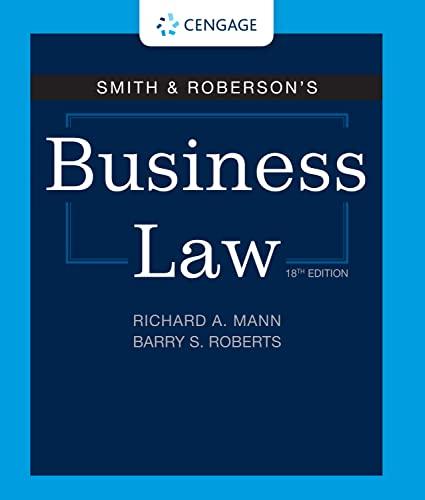Question
Based on the case below please answer the questions below: - What was (were) the issue(s) that the court had to decide in this case?
Based on the case below please answer the questions below:
- What was (were) the issue(s) that the court had to decide in this case?
- What law (statutes, cases, ordinances, regulations, constitutions, etc.) did the court rely upon in deciding the case? Do not just list the names of the cases or the statute numbers. Describe the law, for example: "The court relied upon the First Amendment to the U.S. Constitution which provides that Congress shall make no law abridging the freedom of speech
- Explain how the court applied the Rule to the Facts of this case.
- Explain who won and why? Do you agree with the court's conclusion? Why or why not?
Young v. United Parcel Service, Inc.
Supreme Court of the United States, __ U.S. __, 135 S.Ct. 1338, 191 L.Ed.2d 279 (2015).
Background and Facts Peggy Young was a driver for United Parcel Service, Inc. (UPS). When she became pregnant, her doctor advised her not to lift more than twenty pounds. UPS required drivers to lift up to seventy pounds and told Young that she could not work under a lifting restriction. She filed a suit in a federal district court against UPS, claiming an unlawful refusal to accommodate her pregnancy-related lifting restriction. She alleged that UPS had multiple light-duty-for-injury categories to accommodate individuals whose nonpregnancy-related disabilities created work restrictions similar to hers.
- Why did Young file her suit in a federal district court?
She was claiming pregnancy discrimination and therefore was potentially covered under the federal Pregnancy Discrimination Act. Most employment discrimination lawsuits are indeed filed in federal courts.
UPS responded that, because Young did not fall into any of those categories, it had not discriminated against her. The court issued a summary judgment in UPS's favor. The U.S. Court of Appeals of the Fourth Circuit affirmed the judgment. Young appealed to the United States Supreme Court.
- What is a summary judgment? A summary judgment is entered by a court against one party in favor of the other and it is done so summarily. That is, there is no full trial before the judgment is rendered.
In the Language of the Court
JusticeBREYERdelivered the opinion of the Court.
* * * *
* * * A plaintiff alleging that the denial of an accommodation constituted disparate treatment under the Pregnancy Discrimination Act * * * may make out aprima faciecase by showing that she belongs tothe protected class, that she sought accommodation, that the employer did not accommodate her, and that the employer did accommodate others similar in their ability or inability to work.
The employer may then seek to justify its refusal to accommodate the plaintiff by relying on legitimate, nondiscriminatory reasons for denying her accommodation.[Emphasis added.]
If the employer offers an apparently legitimate, nondiscriminatory reason for its actions, the plaintiff may in turn show that the employer's proffered reasons are in fact pretextual [contrived]. We believe that the plaintiff may reach a jury on this issue by providing sufficient evidence that the employer's policies impose a significant burden on pregnant workers, and that the employer's legitimate, nondiscriminatory reasons are not sufficiently strong to justify the burden, but ratherwhen considered along with the burden imposedgive rise to an inference of intentional discrimination.
The plaintiff can create a genuine issue of material fact as to whether a significant burden exists by providing evidence that the employer accommodates a large percentage of nonpregnant workers while failing to accommodate a large percentage of pregnant workers. Here, for example, if the facts are as Young says they are, she can show that UPS accommodates most nonpregnant employees with lifting limitations while categorically failing to accommodate pregnant employees with lifting limitations. Young might also add that the fact that UPS has multiple policies that accommodate nonpregnant employees with lifting restrictions suggests that its reasons for failing to accommodate pregnant employees with lifting restrictions are not sufficiently strongto the point that a jury could find that its reasons for failing to accommodate pregnant employees give rise to an inference of intentional discrimination.
* * * *
* * * A party is entitled to summary judgment if there is no genuine dispute as to any material fact and the movant [that is, a person who applies to a court for a ruling in his or her favor] is entitled to judgment as a matter of law. * * *Viewing the record in the light most favorable to Young, there is a genuine dispute as to whether UPS provided more favorable treatment to at least some employees whose situation cannot reasonably be distinguished from Young's.[Emphasis added.]
- What does "vacated the judgment" mean?
When a court vacates a judgment, it is effectively cancelling it, or, otherwise stated, rendering it null and void.
- What is aprima faciecase?
Prima facieis a Latin term that means "at first sight." Thus, aprima faciecase is a fact assumed to be true unless it is disproved.Prima faciein the law means the presentation of enough evidence by the claimant to support the legal claimhere pregnancy discrimination.
Step by Step Solution
There are 3 Steps involved in it
Step: 1

Get Instant Access to Expert-Tailored Solutions
See step-by-step solutions with expert insights and AI powered tools for academic success
Step: 2

Step: 3

Ace Your Homework with AI
Get the answers you need in no time with our AI-driven, step-by-step assistance
Get Started


